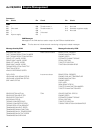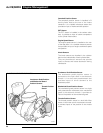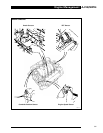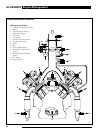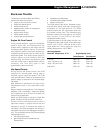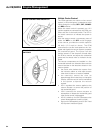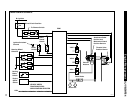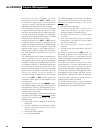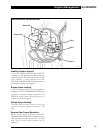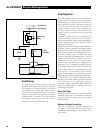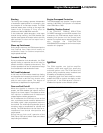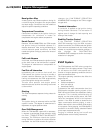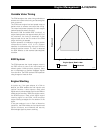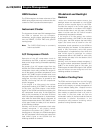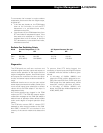
AJ-V8/5HP24
56
Engine Management
Once cruise control is engaged, a further
momentary press of the SET+ or SET- switch
increments or decrements the set speed by
1.6 km/h (1.0 mph). The ECM then accelerates or
decelerates the vehicle to the new set speed.
The ECM stores a maximum of five incremental
or decremental commands at any one time. Once
the ECM has actioned the first stored command,
a further command can be added. On momentary
operation of the opposite sense switch, the ECM
deletes the last command from memory.
Pressing and holding the SET+ or SET- switch
causes the ECM to increase or decrease the set
speed, and smoothly accelerate or decelerate the
vehicle, until the switch is released. To protect
against switch failure in the closed position, if
either switch is held for longer than 10 minutes,
the ECM disables cruise control until the next
ignition cycle.
The throttle pedal can be used to accelerate the
vehicle beyond the set speed, without
disengaging cruise control (since the diaphragm
actuator is holding the mechanical guard, there is
a noticeable reduction in accelerator pedal load
up to the point at which the input shaft in the
electronic throttle begins to turn the mechanical
guard). When the pedal is released the ECM
returns the vehicle to the set speed in a
controlled manner. Alternatively, a momentary
press of the SET+ or SET- switch causes the
increased vehicle speed to be adopted as the
new set speed.
On receipt of an input from the CANCEL switch,
the ECM disengages cruise control and clears the
set speed from memory. Disengagement is in a
controlled manner to provide a smooth return of
throttle control to the driver.
The ECM disengages cruise control, clears the
set speed from memory and immediately
returns
control of the throttle to the driver if any of the
following occur:
• the master switch is pressed, to switch the
system off
• a fault is detected in the electronic throttle
system, the brake switch or the cruise
control switches
• the parking brake is applied
• the engine overspeeds.
The ECM disengages cruise control, immediately
returns control of the throttle to the driver and
r
etains the set speed in memory, if any of the
following occur:
• the brake pedal is pressed
• the vehicle decelerates too fast (ie. as
under heavy braking, to guard against
sticking contacts in the brake switch)
• the gear selector moves to neutral, park
or reverse
• after resuming cruise control the vehicle
accelerates to only 50% of the set speed
(eg. due to a steep hill)
• the stability/traction control system
operates
• vehicle speed decreases below 26 km/h
(16 mph).
On receipt of an input from the RES switch, if a
set speed is stored in the ECM memory, the
cruise control function is re-engaged and the
vehicle accelerated or decelerated to resume the
set speed in a controlled manner.
The ECM continuously monitors the cruise
control switches. If a switch fails closed, on the
initial failure the input is treated as a driver
command and the system responds accordingly.
However, after subsequent disengagement then
re-engagement of the system, the input from the
failed switch is diagnosed as a fault. On detection
of a switch fault, operation of cruise control is
inhibited until the fault is corrected.
The ECM also conducts internal checking
procedures to ensure that only permitted outputs
are generated for given input conditions.



